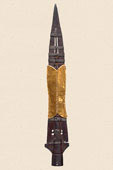
Vienna Lance (Fg. 2-5)
Rough estimates date the Hofburg spear tip to sometime during the 7th century, indicating it likely was added at a later time. It was inside the inscribed wrappings layered around the broken spear where the real discovery happened. A length of metal in the shape of a crucifixion nail, marked by tiny brass crosses which originally brought attention to the metal object. Further investigation revealed traces of cobalt dating to the time of Christ accurately within tolerance, and the nail characteristics fit those of ancient crucifixion nails used during the period. The layers and respective inscriptions were carefully studied, identifying an owner who placed a wrapping for each time the spear was obtained. The historical journey of the Vienna Lance corroborates results of existing physical evidence, highly suggesting it houses one of the few surviving relics subjected to the blood of Christ.
It's interesting to note nails of the cross were sometimes turned into healing trinkets at the time, especially when those nails were obtained from criminal crucifixions. According to most sculptures and artistic renditions of the crucifixion, three nails are shown. Two in the wrists or palms, and one in the feet. Yet the scripture is unclear about this bit and has a mysterious way of wording what happened. Thomas cites use of multiple nails, and John claims one through each wrist, without either mentioning the feet. It's possible Luke could be referring to both the hands and feet, but the passage is equally vague. Knowing this answer might corroborate or disprove the Shroud of Turin, as it appears to show one or two nails used in the feet. We know at least two nails were used by scripture, one of which could be the metal object secured inside Vienna's Lance. The other, claimed in the creation of the Iron Crown of Lombardy. Images of the Shroud suggest the crucifixion nails were placed in the hands of Jesus as he was wrapped. If this is true, perhaps Knights Templar recovered both the nails and Holy Shroud, by duty to protect interests of the Church, placing them in locations to remain safe for hundreds of years.
http://www.mysterypile.com/holy-spear.php
Δεν υπάρχουν σχόλια:
Δημοσίευση σχολίου